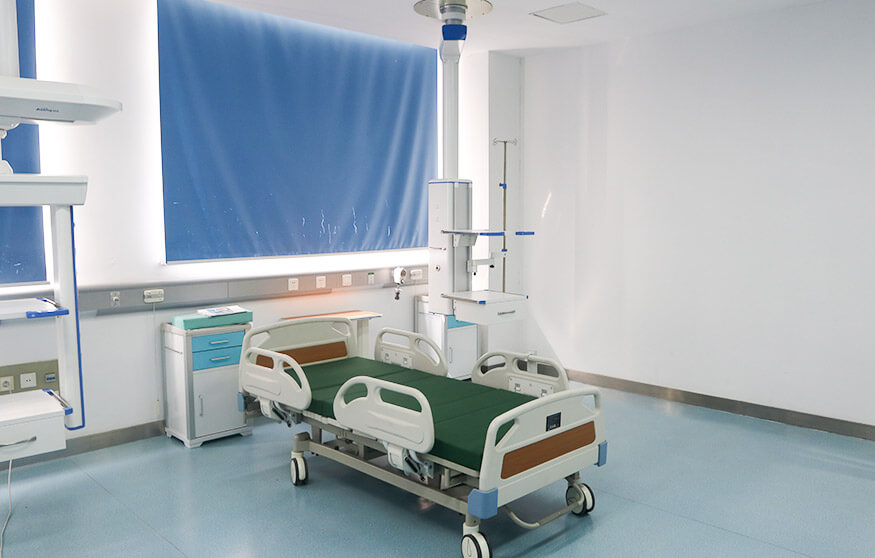The ratio of ICU beds, equipment perfection, personnel quality and rescue effect has become one of the signs to judge the overall level of a hospital.








Because the patients in the ICU ward are different from the patients in the general ward, the ward layout design, environmental requirements, bed functions, and peripheral equipment are all different from those in the general ward. The ward design and equipment configuration should meet the needs, facilitate rescue, and reduce Pollution is the principle.
The establishment of ICU is various. The construction of various ICU is combined with the building structure of each hospital. Because ICU wards are often adjacent to other departments and wards, comprehensive considerations are needed in the design of buildings, and some are nurse stations. The center is surrounded by a intensive care unit; some centers are nurses' stations and the opposite is a fan-shaped array of care beds.
Requirements for ICU anti-pollution are relatively high, because in the ICU, various secondary diseases often cause respiratory failure, the patient must undergo an emergency tracheotomy, emergency open-lung surgery, and also include the recovery of normal post-operative patients, so that in the modern The design of ICU wards should consider the use of laminar flow purification facilities to reduce the chance of infection. The temperature in the ICU should be maintained at 24±1.5°C; the ward temperature in elderly patients should be around 25.5°C.
Each ICU unit's small operating room, pharmacy room, and cleaning room are equipped with UV-lights that are backlit, regularly sterilized, and equipped with an ultraviolet ray sterilizer to sterilize the unmanned space on a regular basis.
The use of electrical and electronic equipment in the ICU is relatively centralized. Therefore, in the design of the ICU, it is necessary to ensure adequate power supply. It is preferable to provide dual-circuit and emergency power. Important equipment should be equipped with an uninterruptible power supply (UPS).
The ICU should be equipped with a variety of gas lines, preferably using a central supply of oxygen, central supply air, and a central suction vacuum. In particular, the central oxygen supply can ensure that the ICU patients continuously absorb oxygen in large quantities, eliminating the frequent replacement of oxygen cylinders and preventing contamination of the ICU with oxygen cylinders.
ICU bed matching is suitable for the characteristics of ICU patients, has following requirements:
1.The bed head, the bed foot can be rocking high, rocking low, and can be disassembled, the head of the bed and the wall guarantee not less than 60 cm clearance, easy to rescue the patient when the medical staff from all directions;
2.The hospital bed is equipped with casters and braking devices, which can adjust the height and inclination of the whole bed.
3. Beds with corrugated or porous mattress, preferably equipped with inflatable anti bedsore air cushion, prevent ICU patients from lying in bed for a long time and have bedsore.
4.The ceiling of the bed is provided with an infusion day rail, two or three free mobile infusion hangers, and a surround or hanging curtain on both sides of the bed. It is convenient to separate the beds from other beds when rescuing the critically ill.
The equipment of ICU is basically set around the hospital bed. The purpose is to facilitate the use of ventilator, monitor and other electronic equipment and rescue equipment. Therefore, there are 1 power switches, a multi-purpose power outlet that can be connected with the plug at the same time, a 2~3 set of central oxygen supply device, 2 sets of compressed air devices, a 2~3 set of negative pressure suction devices, 1 sets of brightness adjustable headlights, and 1 sets of emergency lights on the bedside panel of each bed. A functional column with two sides is set up between the two beds, with power outlets, equipment shelving, gas interfaces, calling devices, etc.
Every ICU unit must be equipped with conventional equipment when running normally. ICU should be equipped with the corresponding routine equipment: ECG monitor, ventilator, infusion pump, microinjection pump, defibrillator, and cardiopulmonary resuscitation apparatus, fiberoptic bronchoscope, fiber laryngoscope, manual auxiliary air bag and so on. On the equipment shelf of the standby infusion pump and the injection pump, the accessories and related articles of the electronic equipment, such as the blood pressure cuff, the pulse oxygen probe, the standby power connection board, the ventilator pipe, the humidifier, the various joints, the deep vein intubation, the breathing air bag, the face mask, the balloon counterpulsation tube and the equipment and equipment to be used with the equipment It is.
There should be a first-aid drug cabinet, a refrigerator and a consumable instrument cabinet in the medical equipment room. The instrument cabinet is a drawer type, and all kinds of consumable instruments are stored for use. In the consumption instrument cabinet, there are tracheal intubation, infusion pump tube, sputum suction tube, drainage tube, drainage device, nasal catheter, negative pressure drainage bag and syringe, infusion apparatus, gloves, rubber cloth, gauze cotton swab and other common nursing articles.
Monitoring equipment is the basic equipment of ICU. The monitor can monitor the waveform or parameters such as ECG, blood pressure (invasive or noninvasive), respiration, blood oxygen saturation, temperature and other parameters in real time and dynamically, and can analyze and deal with the measured parameters, data storage, waveform replay and so on. During the construction of ICU, the monitoring equipment is divided into two categories: single bed independent monitoring system and central monitoring system.
Need more information or want to place an order? Contact your Rooe sales representative. If you’re new to Rooe, let us know how to reach you and we’ll get the right person in touch.
Read More